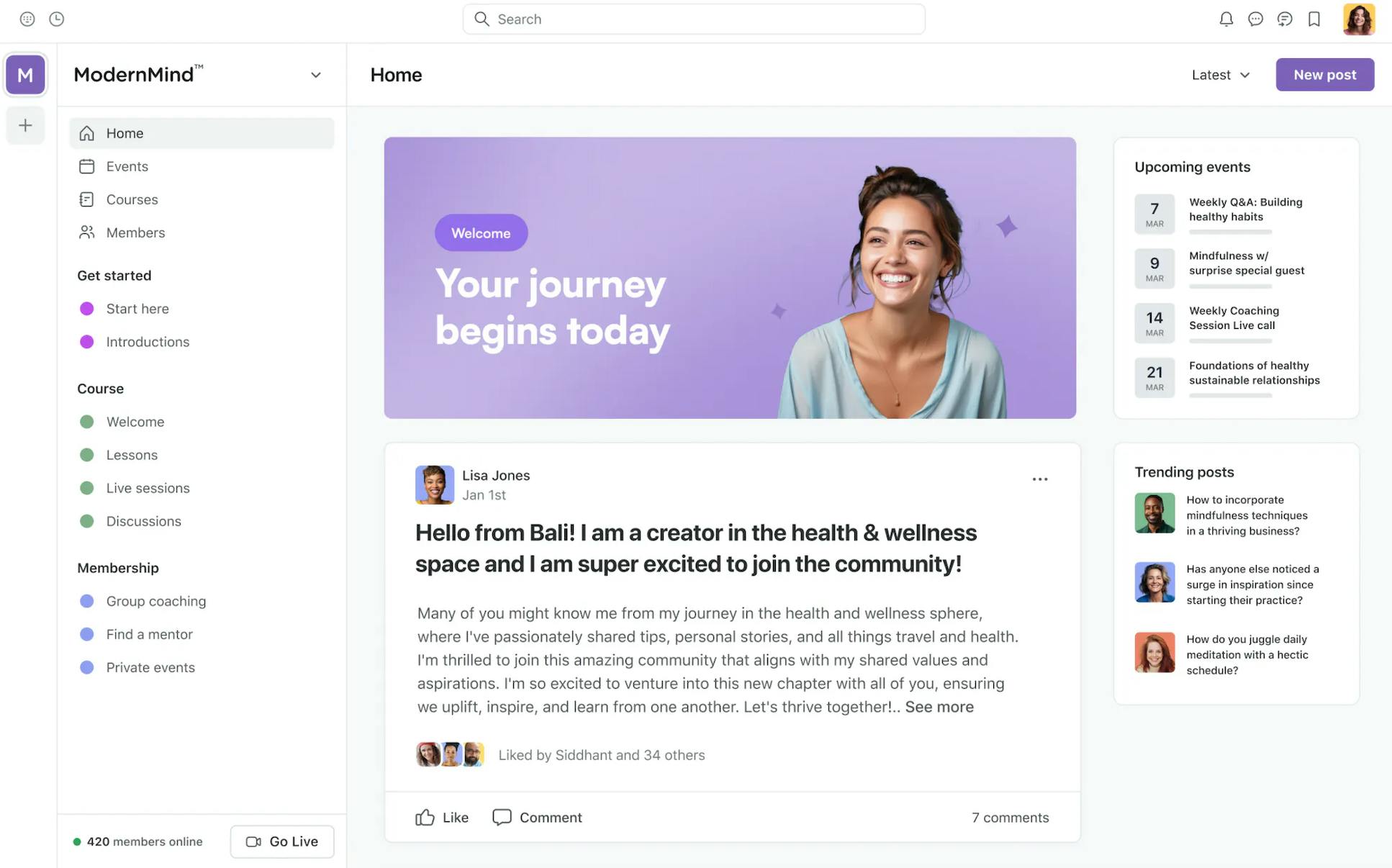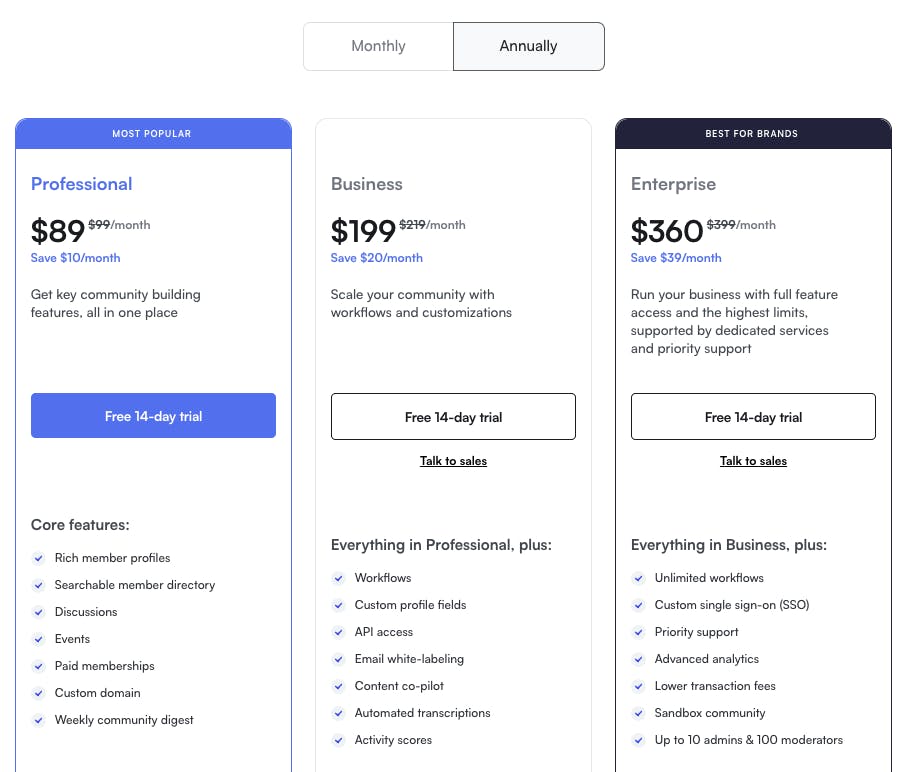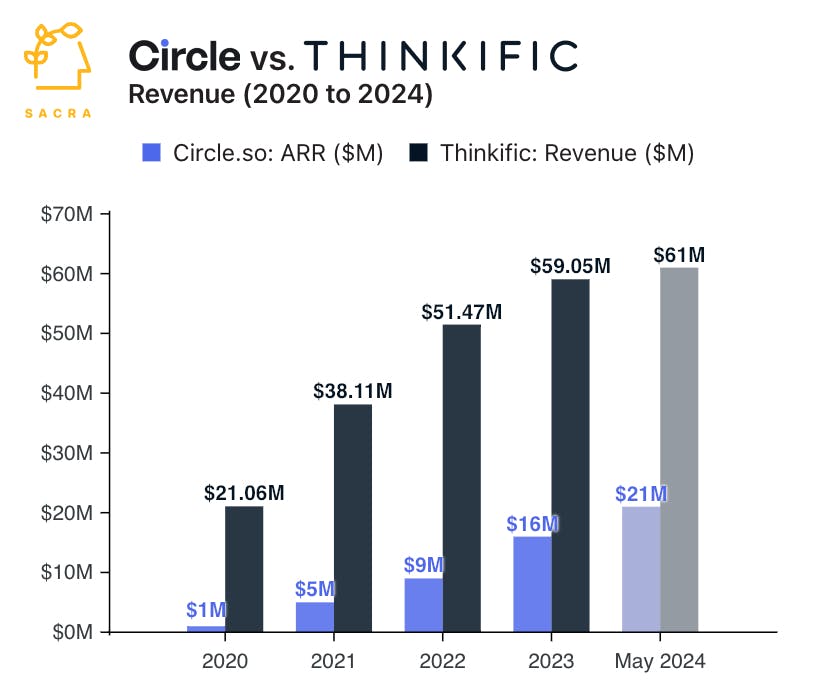
Revenue
$21.00M
2024
Valuation
$250.00M
2023
Funding
$30.40M
2024
Growth Rate (y/y)
75%
2024
Revenue
Sacra estimates that Circle hit $21M in annual recurring revenue (ARR) in May 2024, up 75% from $12M in May 2023 and up from $16M ARR at the end of 2023.
After being founded in early 2020, Circle reached $1M ARR at the end of its first year and $4M ARR by the end of 2021. Monthly gross merchandise value (GMV) hit $4.14M in October 2023, up 300% year-over-year.
Circle generates revenue through subscription plans for its all-in-one community platform, with pricing ranging from $49-$399+ per month. The company was serving 4.1M active users and more than 10,000 communities as of the end of 2023, including creators like Ali Abdaal and brands like SpaceX and Oprah Daily.
Valuation & Funding
Circle was valued at $200M as of November 2021, with a reported subsequent valuation of $250M. The company has raised $30.2M across 5 funding rounds. Key investors include Tiger Global Management, Notation Capital, and Bossa Invest. Notable individual investors include Ankur Nagpal and Brendon Burchard.
Product

Circle was founded in January 2020 by Sid Yadav, Andy Guttormsen, and Rudy Santino.
The idea behind Circle was to enable creators to monetize their communities with memberships in the same way that Substack, ConvertKit and Beehiiv made it simple for creators to launch paid newsletters.
Unlike Slack which is very expensive for communities (~$.0079/member on Circle vs. $7.25/member on Slack) and unlike Facebook Groups which keeps your engagement on its own platform, Circle charges a lower SaaS fee and enables you to own your audience and monetize it directly.
Circle found initial product-market fit with online course creators, with the platform's white-label community features, coupled with built-in monetization tools, resonating with niche online creators like Tiago Forte.
Circle capitalized on the surge in online communities during the COVID-19 pandemic, growing from 5 employees and their first paying customer in early 2020 to over 4,000 paying communities by late 2021.
Key features of Circle include:
1. Customizable community spaces: Users can create various types of spaces for discussions, courses, and events.
2. White-label branding: Communities can be fully branded to match the creator's aesthetic.
3. Built-in monetization: Tools for paid memberships and gated content.
4. Integration capabilities: Seamless connections with popular tools like Zapier and ConvertKit.
5. Mobile apps: Native iOS and Android apps for community members.
As of 2023, Circle has expanded its offering to include features like automated workflows, AI-powered content assistance, and analytics tools. The platform now serves over 4,000 paying communities with a total of 2 million members, positioning itself as a comprehensive solution for creators and brands looking to build and engage their online communities.
Business Model

Circle is a subscription SaaS company that provides an all-in-one community platform for creators and brands. The company generates revenue through tiered subscription plans, with pricing based on the number of active members and features required. Circle offers three main plans: Basic, Professional, and Enterprise, with monthly fees ranging from $39 to $399 per month when billed annually.
The company's core value proposition lies in its ability to consolidate various community engagement tools into a single, white-labeled platform. This includes features such as discussions, live streaming, courses, and events. By offering a comprehensive solution, Circle reduces the need for creators and brands to piece together multiple tools.
Circle offers a 14-day free trial, allowing potential customers to experience the platform's full functionality before committing to a paid plan. This approach not only lowers customer acquisition costs but also enables organic growth through word-of-mouth referrals within creator networks.
A key element of Circle's strategy is its focus on integration and customization. The platform seamlessly integrates with popular tools like Zapier, ConvertKit, and Teachable, allowing users to maintain their existing workflows. Additionally, the white-label feature enables creators to maintain their brand identity.
Competition
Circle competes in the rapidly growing market for community and creator platforms. The competitive landscape can be divided into three main categories: all-in-one creator platforms, specialized community tools, and course creation platforms.
All-in-One Creator Platforms
In the category of all-in-one platforms for communities, Circle faces competition from established players like Mighty Networks and newer entrants such as Geneva. These platforms offer a comprehensive suite of features for building and managing online communities, including discussion forums, content hosting, and monetization tools.
In addition, companies across the creator economy are going all-in-one, converting integrations into native SKUs to grow average revenue per user (ARPU) as Circle has done with courses (Thinkific), paid events (Eventbrite), and payments (Gumroad).
From Beehiiv and ConvertKit launching ad networks to link-in-bio platforms like Stan and Beacons bundling features like email, scheduling, and payments to Passes layering video calls, paid DMs and live streams onto their membership product, every creator economy company is looking to build the all-in-one Shopify for their niche.
Specialized Community Tools
This segment includes platforms that excel in specific aspects of community management. Discourse dominates the forum space with its open-source solution, while Slack and Discord lead in real-time chat. Circle competes by offering a more balanced approach, combining asynchronous discussions with real-time chat capabilities. Its strength lies in providing a unified platform that eliminates the need for creators to cobble together multiple tools. Circle's workflow automation features and custom branding options give it an edge over more generic solutions like Facebook Groups.
Course Creation Platforms

While not primarily focused on courses, Circle competes with platforms like Teachable and Kajabi in the online education space. These platforms offer robust course creation and delivery tools but often lack strong community features. Circle's advantage is its ability to seamlessly integrate community engagement with course delivery, providing a more holistic learning experience. This is particularly appealing to creators who want to build ongoing relationships with their audience beyond just course delivery.
Circle's position in the market is strengthened by its focus on the creator economy and its understanding of the unique needs of online community builders. By offering a flexible, all-in-one solution that can be tailored to different use cases, Circle has carved out a niche that appeals to creators looking for a balance between functionality and ease of use. However, the company faces challenges in competing with more established players in each category and must continue to innovate to maintain its competitive edge in a rapidly evolving market.
TAM Expansion
Circle has tailwinds from the growth of the creator economy and the increasing demand for online community platforms—it also has opportunities to grow and expand upmarket into enterprise community management and into adjacent markets like professional networking.
Creator Economy Tailwinds
The creator economy continues to experience explosive growth, with more individuals monetizing their expertise and building audiences online. This trend provides a strong foundation for Circle's core business of powering creator-led communities. As creators seek more control over their platforms and direct relationships with their audiences, Circle is well-positioned to capture market share from less specialized alternatives like Facebook Groups or Slack.
Circle can expand its offerings to serve larger creators and brands, potentially moving upmarket to compete with enterprise community platforms. By enhancing its analytics, moderation tools, and integration capabilities, Circle could attract bigger clients with more complex needs and higher budgets. This expansion would increase average revenue per customer and open up a larger total addressable market.
Professional Networking
As remote work becomes more prevalent, there's an increasing need for online spaces that facilitate professional networking and collaboration. Circle could expand into this market by developing features specifically tailored for professional communities, such as job boards, mentorship matching, and skill-sharing marketplaces.
This expansion would position Circle as a competitor to LinkedIn Groups and other professional networking platforms, but with a stronger focus on fostering active, engaged communities. By emphasizing privacy and exclusivity, Circle could attract high-value professional networks and industry associations looking for alternatives to public social media platforms.
By pursuing these expansion opportunities, Circle has the potential to significantly increase its total addressable market and solidify its position as a leading platform in the broader online community space. The company's existing expertise in community engagement and its flexible, customizable platform provide a strong foundation for growth into these adjacent markets.
News
DISCLAIMERS
This report is for information purposes only and is not to be used or considered as an offer or the solicitation of an offer to sell or to buy or subscribe for securities or other financial instruments. Nothing in this report constitutes investment, legal, accounting or tax advice or a representation that any investment or strategy is suitable or appropriate to your individual circumstances or otherwise constitutes a personal trade recommendation to you.
This research report has been prepared solely by Sacra and should not be considered a product of any person or entity that makes such report available, if any.
Information and opinions presented in the sections of the report were obtained or derived from sources Sacra believes are reliable, but Sacra makes no representation as to their accuracy or completeness. Past performance should not be taken as an indication or guarantee of future performance, and no representation or warranty, express or implied, is made regarding future performance. Information, opinions and estimates contained in this report reflect a determination at its original date of publication by Sacra and are subject to change without notice.
Sacra accepts no liability for loss arising from the use of the material presented in this report, except that this exclusion of liability does not apply to the extent that liability arises under specific statutes or regulations applicable to Sacra. Sacra may have issued, and may in the future issue, other reports that are inconsistent with, and reach different conclusions from, the information presented in this report. Those reports reflect different assumptions, views and analytical methods of the analysts who prepared them and Sacra is under no obligation to ensure that such other reports are brought to the attention of any recipient of this report.
All rights reserved. All material presented in this report, unless specifically indicated otherwise is under copyright to Sacra. Sacra reserves any and all intellectual property rights in the report. All trademarks, service marks and logos used in this report are trademarks or service marks or registered trademarks or service marks of Sacra. Any modification, copying, displaying, distributing, transmitting, publishing, licensing, creating derivative works from, or selling any report is strictly prohibited. None of the material, nor its content, nor any copy of it, may be altered in any way, transmitted to, copied or distributed to any other party, without the prior express written permission of Sacra. Any unauthorized duplication, redistribution or disclosure of this report will result in prosecution.